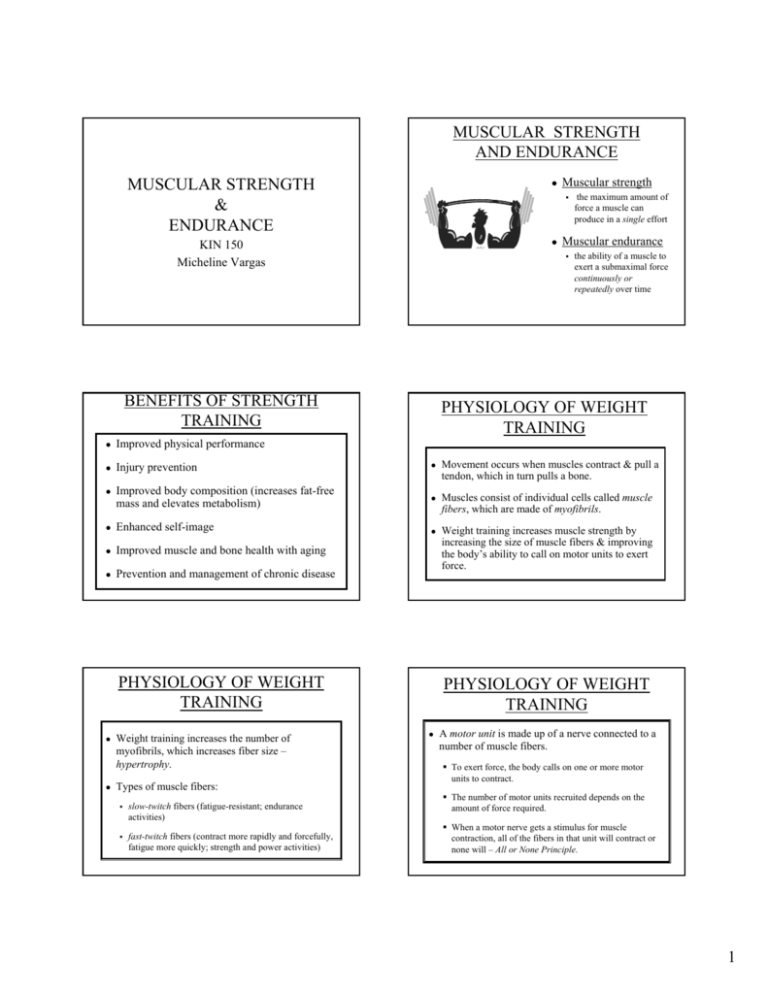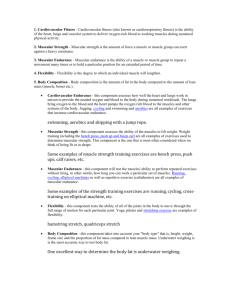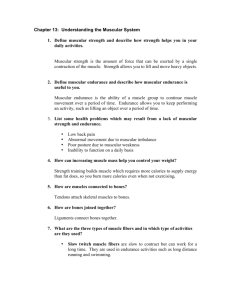Muscular Strength & Endurance Physiology Of Weight Training
advertisement

MUSCULAR STRENGTH AND ENDURANCE MUSCULAR STRENGTH & ENDURANCE z KIN 150 Micheline Vargas z Improved physical performance z Injury prevention z Improved body composition (increases fat-free mass and elevates metabolism) z Enhanced self-image z Improved muscle and bone health with aging z Prevention and management of chronic disease z PHYSIOLOGY OF WEIGHT TRAINING z z Weight training increases the number of myofibrils, which increases fiber size – hypertrophy. Types of muscle fibers: slow-twitch fibers (fatigue-resistant; endurance activities) fast-twitch fibers (contract more rapidly and forcefully, fatigue more quickly; strength and power activities) the ability of a muscle to exert a submaximal force continuously or repeatedly over time PHYSIOLOGY OF WEIGHT TRAINING z z the maximum amount of force a muscle can produce in a single effort Muscular endurance BENEFITS OF STRENGTH TRAINING z Muscular strength Movement occurs when muscles contract & pull a tendon, which in turn pulls a bone. Muscles consist of individual cells called muscle fibers, which are made of myofibrils. Weight training increases muscle strength by increasing the size of muscle fibers & improving the body’s ability to call on motor units to exert force. PHYSIOLOGY OF WEIGHT TRAINING z A motor unit is made up of a nerve connected to a number of muscle fibers. To exert force, the body calls on one or more motor units to contract. The number of motor units recruited depends on the amount of force required. When a motor nerve gets a stimulus for muscle contraction, all of the fibers in that unit will contract or none will – All or None Principle. 1 TYPES OF WEIGHT TRAINING PHYSIOLOGICAL CHANGES / BENEFITS OF WEIGHT TRAINING Changes Muscle mass Ç Utilization of motor units Coordination of motor units Strength of tendons, ligaments, & bones Storage of fuel in muscles Size of fast-twitch fibers Size of slow-twitch fibers Blood supply to muscle Ç Ç Ç Ç Ç Ç Ç Benefits Ç Ç Ç È Ç Ç Ç Ç Ç Biochemical improvements Improved blood fat levels Ç Ç Ç Ç Isometric (static) - application of force without movement z Strength, body composition, metabolic rate, toned muscles Muscular strength / power Muscular strength / power Risk of injury of these tissues Isotonic (dynamic) - application of force with movement z Resistance to muscle fatigue Muscular strength / power Muscular endurance Delivery of O2 & nutrients Elimination of wastes Enhanced metabolic health Reduced risk of heart disease z Selecting Exercises: All major muscle groups should be worked 8-10 different exercises are required to work all major muscle groups. Agonist and antagonist muscles should be worked z To build endurance, lift weights 40-60% of your maximum capacity. 15-20 reps / 1-3 sets z To build general fitness, lift weights 70-80% of your maximum capacity. Safe Convenient Spotter not required Balance not required Variable resistance Less skill required Less time between exercises Muscle group isolation Back support ADVANTAGES z Allows dynamic movement Develop control of weights Variety of exercises Widely available Functional DISADVANTAGES z Spotter required Not as safe Skill required Cause more blisters and calluses MAKING PROGRESS z Warm-up z z Cool-down z Maintenance z Starting weight z Frequency of exercise z Adding weight z Recovery 1-5 reps / 1-5+ sets z variable resistance Availability Limited # of exercises Inappropriate for dynamic movements RESISTANCE / REPS / SETS To build strength, lift weights 80% of you maximum capacity. • DISADVANTAGES Large muscle groups should be exercised first. z constant resistance ADVANTAGES Choosing Equipment: Machines -vs- Free Weights z • MACHINES - VS - FREE WEIGHTS CREATING A PROGRAM z Common types of isotonic techniques: Improvement during the first 6-10 weeks 8-12 reps / 1 or more sets 2 WEIGHT TRAINING SAFETY CAUTION ABOUT SUPPLEMENTS z z Use proper lifting technique z Use spotters and collars with free weights z Use common sense with weight machines z keep away from moving parts and weight stacks adjust machines as needed be sure machines are clean and in good condition be aware of your surroundings Be alert for injuries Supplements Taken to Increase Muscle Growth z Growth hormones Dehydroepiandrosterone (DHEA) Insulin Insulin-like growth factor (IGF-1) Protein & amino acid supplements Supplements Taken to Speed Recovery Creatine monohydrate Chromium picolinate Carbohydrate beverages z Substances Marketed to Weight Trainers Carnitine Ephedrine Ginseng HMB (beta-hydroxy-beta-methylbutyrate) Vitamin B12 3









